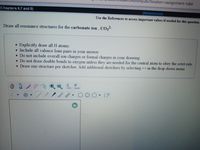
Chemistry
10th Edition
ISBN: 9781305957404
Author: Steven S. Zumdahl, Susan A. Zumdahl, Donald J. DeCoste
Publisher: Cengage Learning
expand_more
expand_more
format_list_bulleted
Question

Transcribed Image Text:vity.do?locator=assignment-take
Chapters 6,7 and 8)
[References)
Use the References to access important values if needed for this question.
Draw all resonance structures for the carbonate ion , CO².
Explicitly draw all H atoms.
• Include all valence lone pairs in your answer.
• Do not include overall ion charges or formal charges in your drawing.
• Do not draw double bonds to oxygen unless they are needed for the central atom to obey the octet rule.
• Draw one structure per sketcher. Add additional sketchers by selecting + in the drop-down menu
opy
aste
Expert Solution
This question has been solved!
Explore an expertly crafted, step-by-step solution for a thorough understanding of key concepts.
This is a popular solution
Trending nowThis is a popular solution!
Step by stepSolved in 2 steps with 2 images

Knowledge Booster
Similar questions
- carbon tetrachloride was formerly used in fire extinguishers for electrical fires.it is no longer used for this purpose because of the formation of the toxic gas phosgene,CL2CO.wRITE THE LEWIS STRUCTURES for the methane and ethane molecules.arrow_forwardSelect the best Lewis structure for P2I4, predict the electron group arrangement of each central atom and the shape of this molecule.arrow_forwardWhat possible error(s) exist in the Lewis structure (assume we are trying to represent the best possible Lewis structure for the NO₂S ion knowing N is the central atom in this polyatomic ion)? [:ö==S: N= CO :O: The best structure would have double bond and two lone pairs on each oxygen atom and a single bond with three lone pairs on the sulfur. There are no errors. This is the best possible structure. The Lewis structure above does not minimize formal charges, thus is the not the best possible structure. The nitrogen atom has an expanded octet, and this structure is impossible. The Lewis structure contains the wrong number of electrons, thus this structure is impossible.arrow_forward
- In the nitrite ion (NO₂), Consider the implications of resonance.arrow_forwardWhat would the resonance structures of H2SeO3 be which feature an expanded octet?arrow_forwardKeeping in mind that some elements violate the octet rule, draw a Lewis structure for each compound: (a) BeH 2; (b) PCl 5.arrow_forward
- What is the formal charge on each atom in HNO3 and the Lewis structure for it?arrow_forwardWrite resonance forms that describe the distribution of electrons in each of these molecules or ions. a) nitric acid, HNO3 (N is bonded to an OH group and two O atoms) b) benzene, C6H6: c)the formate ion:arrow_forwardDraw all resonance structures for the sulfur trioxide molecule, SO3.arrow_forward
- An incompicie Lewis structure is shown below. The structure only shows the atoms and how they are connected. The molecule has a net charge of -1. N-C-C-H Complete the Lewis structure giving all atoms full octets. If there is more than one way to do this, draw resonance structures showing all possibilities. If not, just draw one Lewis structure. Be sure to write in any non-zero formal charges. H N=c=c-Harrow_forwardThe structure of sodium hyaluronate, a sodium salt of hyaluronic acid used in skincare products for its hydrating properties, is shown below. What is the shape of the bonds at (ii) ? Hint: atom (iii) has been completed for you as an example. (iii) bond angle: 109.5°, geometry of the electron pairs: tetrahedral, shape of the bonds: tetrahedral ОН, OH ·•·•·||||| N O H H Ol.. OH |||| iv + Naarrow_forward(a) True or false: The hydrogen atom is most stable when ithas a full octet of electrons. (b) How many electrons must asulfur atom gain to achieve an octet in its valence shell? (c) Ifan atom has the electron configuration 1s22s22p3, how manyelectrons must it gain to achieve an octet?arrow_forward
arrow_back_ios
SEE MORE QUESTIONS
arrow_forward_ios
Recommended textbooks for you
 ChemistryChemistryISBN:9781305957404Author:Steven S. Zumdahl, Susan A. Zumdahl, Donald J. DeCostePublisher:Cengage Learning
ChemistryChemistryISBN:9781305957404Author:Steven S. Zumdahl, Susan A. Zumdahl, Donald J. DeCostePublisher:Cengage Learning ChemistryChemistryISBN:9781259911156Author:Raymond Chang Dr., Jason Overby ProfessorPublisher:McGraw-Hill Education
ChemistryChemistryISBN:9781259911156Author:Raymond Chang Dr., Jason Overby ProfessorPublisher:McGraw-Hill Education Principles of Instrumental AnalysisChemistryISBN:9781305577213Author:Douglas A. Skoog, F. James Holler, Stanley R. CrouchPublisher:Cengage Learning
Principles of Instrumental AnalysisChemistryISBN:9781305577213Author:Douglas A. Skoog, F. James Holler, Stanley R. CrouchPublisher:Cengage Learning Organic ChemistryChemistryISBN:9780078021558Author:Janice Gorzynski Smith Dr.Publisher:McGraw-Hill Education
Organic ChemistryChemistryISBN:9780078021558Author:Janice Gorzynski Smith Dr.Publisher:McGraw-Hill Education Chemistry: Principles and ReactionsChemistryISBN:9781305079373Author:William L. Masterton, Cecile N. HurleyPublisher:Cengage Learning
Chemistry: Principles and ReactionsChemistryISBN:9781305079373Author:William L. Masterton, Cecile N. HurleyPublisher:Cengage Learning Elementary Principles of Chemical Processes, Bind...ChemistryISBN:9781118431221Author:Richard M. Felder, Ronald W. Rousseau, Lisa G. BullardPublisher:WILEY
Elementary Principles of Chemical Processes, Bind...ChemistryISBN:9781118431221Author:Richard M. Felder, Ronald W. Rousseau, Lisa G. BullardPublisher:WILEY

Chemistry
Chemistry
ISBN:9781305957404
Author:Steven S. Zumdahl, Susan A. Zumdahl, Donald J. DeCoste
Publisher:Cengage Learning

Chemistry
Chemistry
ISBN:9781259911156
Author:Raymond Chang Dr., Jason Overby Professor
Publisher:McGraw-Hill Education

Principles of Instrumental Analysis
Chemistry
ISBN:9781305577213
Author:Douglas A. Skoog, F. James Holler, Stanley R. Crouch
Publisher:Cengage Learning

Organic Chemistry
Chemistry
ISBN:9780078021558
Author:Janice Gorzynski Smith Dr.
Publisher:McGraw-Hill Education

Chemistry: Principles and Reactions
Chemistry
ISBN:9781305079373
Author:William L. Masterton, Cecile N. Hurley
Publisher:Cengage Learning

Elementary Principles of Chemical Processes, Bind...
Chemistry
ISBN:9781118431221
Author:Richard M. Felder, Ronald W. Rousseau, Lisa G. Bullard
Publisher:WILEY